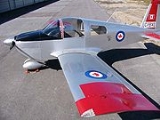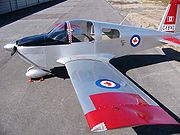
Leading edge
Encyclopedia

As an example of the distinction, during a tailslide, from an aerodynamic point-of-view, the trailing edge
Trailing edge
The trailing edge of an aerodynamic surface such as a wing is its rear edge, where the airflow separated by the leading edge rejoins. Essential control surfaces are attached here to redirect the air flow and exert a controlling force by changing its momentum...
becomes the leading edge and vice-versa but from a structural point of view the leading edge remains unchanged.
The structural leading edge may be equipped with one or more of the following:
- Leading edge bootsDeicing bootA deicing boot is a type of ice protection system installed on aircraft surfaces to permit a mechanical deicing in flight. Such boots are generally installed on the leading edges of wings and control surfaces A deicing boot is a type of ice protection system installed on aircraft surfaces to permit...
- Leading edge cuffLeading edge cuffLeading edge cuffs are a fixed aerodynamic device employed on fixed-wing aircraft to modify the airfoil used. They may be either factory-installed or, more commonly, an after-market modification....
s - Leading edge extensionLeading edge extensionA leading edge extension is a small extension to an aircraft wing surface, forward of the leading edge. Different kinds of extensions have been used for different reasons.-Leading edge slats:...
s - Leading edge slatsLeading edge slatsSlats are aerodynamic surfaces on the leading edge of the wings of fixed-wing aircraft which, when deployed, allow the wing to operate at a higher angle of attack. A higher coefficient of lift is produced as a result of angle of attack and speed, so by deploying slats an aircraft can fly at slower...
- Leading edge slotLeading edge slotA leading edge slot is an aerodynamic feature of the wing of some aircraft to reduce the stall speed and promote good low-speed handling qualities. A leading edge slot is a span-wise gap in each wing, allowing air to flow from below the wing to its upper surface...
s - Krueger flapsKrueger flapsKrueger flaps are lift enhancement devices that may be fitted to the leading edge of an aircraft wing. Unlike slats or drooped leading edges, the main wing upper surface and its nose is not changed...
- Stall stripsStall stripsA stall strip is a fixed aerodynamic device employed on fixed-wing aircraft to modify the airfoil used. They are usually factory-installed or, on rarer occasion, an after-market modification. Stall strips are almost always employed in pairs, symmetrically on both wings...
- Vortex generatorVortex generatorA vortex generator is an aerodynamic surface, consisting of a small vane or bump that creates a vortex. Vortex generators can be found on many devices, but the term is most often used in aircraft design....
s.
Associated terms are leading edge radius and leading edge stagnation point
Stagnation point
In fluid dynamics, a stagnation point is a point in a flow field where the local velocity of the fluid is zero. Stagnation points exist at the surface of objects in the flow field, where the fluid is brought to rest by the object...
.
Seen in plan the leading edge may be straight or curved. A straight leading edge may be swept or unswept, the latter meaning that it is perpendicular to the longitudinal axis of the aircraft. As wing sweep
Swept wing
A swept wing is a wing planform favored for high subsonic jet speeds first investigated by Germany during the Second World War. Since the introduction of the MiG-15 and North American F-86 which demonstrated a decisive superiority over the slower first generation of straight-wing jet fighters...
is conventionally measured at the 25% chord
Chord (aircraft)
In aeronautics, chord refers to the imaginary straight line joining the trailing edge and the center of curvature of the leading edge of the cross-section of an airfoil...
line an unswept wing may have a swept or tapered leading edge. Some aircraft, like the General Dynamics F-111
General Dynamics F-111
The General Dynamics F-111 "Aardvark" was a medium-range interdictor and tactical strike aircraft that also filled the roles of strategic bomber, reconnaissance, and electronic warfare in its various versions. Developed in the 1960s by General Dynamics, it first entered service in 1967 with the...
, have swing-wing
Swing-wing
A variable-sweep wing is an aeroplane wing that may be swept back and then returned to its original position during flight. It allows the aircraft's planform to be modified in flight, and is therefore an example of a variable-geometry aircraft....
s where the sweep of both wing and leading edge can be varied.
In high-speed aircraft, compression heating of the air ahead of the wings can cause extreme heating of the leading edge. Heating was a major contributor to the destruction of the Space Shuttle Columbia
Space Shuttle Columbia
Space Shuttle Columbia was the first spaceworthy Space Shuttle in NASA's orbital fleet. First launched on the STS-1 mission, the first of the Space Shuttle program, it completed 27 missions before being destroyed during re-entry on February 1, 2003 near the end of its 28th, STS-107. All seven crew...
during re-entry on February 1, 2003.

